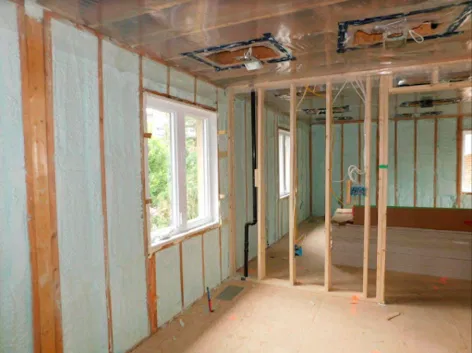ABOUT EXTERIOR WALL INSULATION
Exterior wall insulation improvements were uncommon, even though walls often account for 25 to 35 percent of the heat loss of a typical existing home. Footnote 2 As Canadian jurisdictions introduce carbon pricing and policies targeting net-zero energy housing, significant levels of investment can be anticipated in housing.
Exterior wall insulation is crucial for optimizing energy efficiency and ensuring year-round comfort in residential and commercial buildings. With Ontario’s climate varying from cold winters to warm summers, effective insulation helps reduce heating and cooling costs while enhancing indoor comfort levels.

Types of Insulation Used:
- EIFS (Exterior Insulation and Finish Systems):
- Rigid Foam Insulation (XPS or EPS):
- Spray Foam Insulation (Closed-Cell):
Also better to know that “Drill and fill” is a method of retrofitting insulation into existing walls, particularly exterior walls, where insulation may be lacking or inadequate. This technique is commonly used to improve energy efficiency and thermal comfort in older homes or buildings without tearing down and replacing existing walls. Here’s how the drill and fill process typically works:
A. Assessment and Preparation: Inspect walls and prepare for access by temporarily removing exterior finishes.
B. Drilling Access Holes: Drill small holes between wall studs to access the cavity.
C. Insulation Injection: Pump or blow insulation material (like cellulose or foam) into the wall cavity.
D.Sealing and Patching: Seal access holes and weatherproof to prevent moisture intrusion.

Advantages of Exterior Wall Insulation:
- Energy Savings: By minimizing heat transfer through walls, insulation reduces the need for heating and cooling, resulting in lower energy bills and reduced environmental impact.
- Improved Comfort: Maintains more stable indoor temperatures throughout the year, ensuring a comfortable living or working environment regardless of outdoor weather conditions.
- Moisture Control: Effective insulation systems help manage moisture infiltration, preventing mold growth and preserving building integrity over time.
- Enhanced Building Durability: Protects exterior walls from temperature fluctuations and moisture damage, extending the lifespan of building materials.

Considerations for Installation:
- Professional Expertise: Proper installation by trained professionals is crucial to ensure insulation effectiveness, adherence to building codes, and integration with existing structures and cladding.
- Building Codes Compliance: Adherence to local building codes regarding insulation thickness, fire safety requirements, and moisture management strategies is essential for project success.
- Maintenance: Regular inspection and maintenance of insulation systems ensure long-term performance and energy efficiency benefits.
In conclusion, selecting the right exterior wall insulation in the GTA involves considering climate conditions, building design, and performance requirements. Consulting with insulation experts and contractors can provide valuable guidance in choosing and installing the most suitable insulation system for optimal energy efficiency and comfort in residential and commercial buildings alike.
Feel free to reach out to us anytime with your questions; we’re here to help!
Government Energy Rebate
Let Free Attic help YOU reduce your energy use up to 50%! Saving you Energy and Money through a Government Rebate! Cut the cost of heating your home with a simple Upgrade to your Home Insulation We will even help you apply for your Rebate! RELAX we got this!
